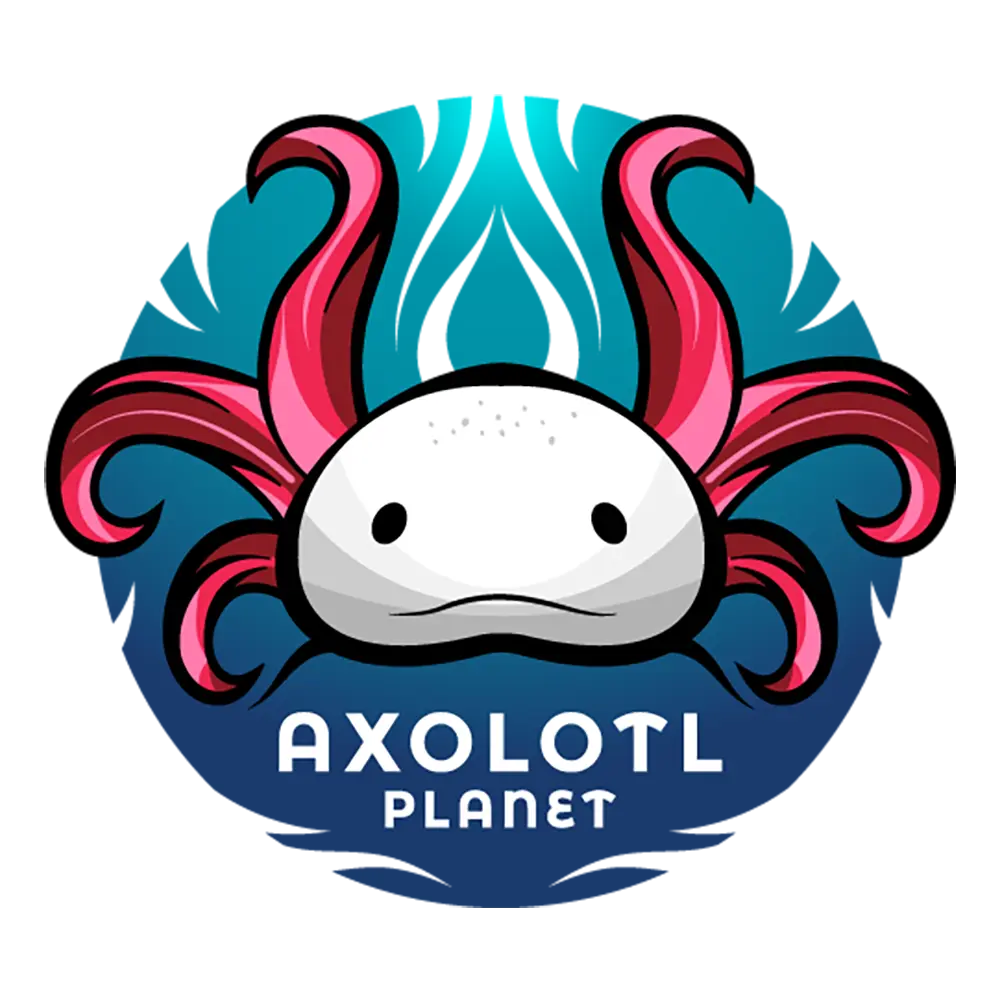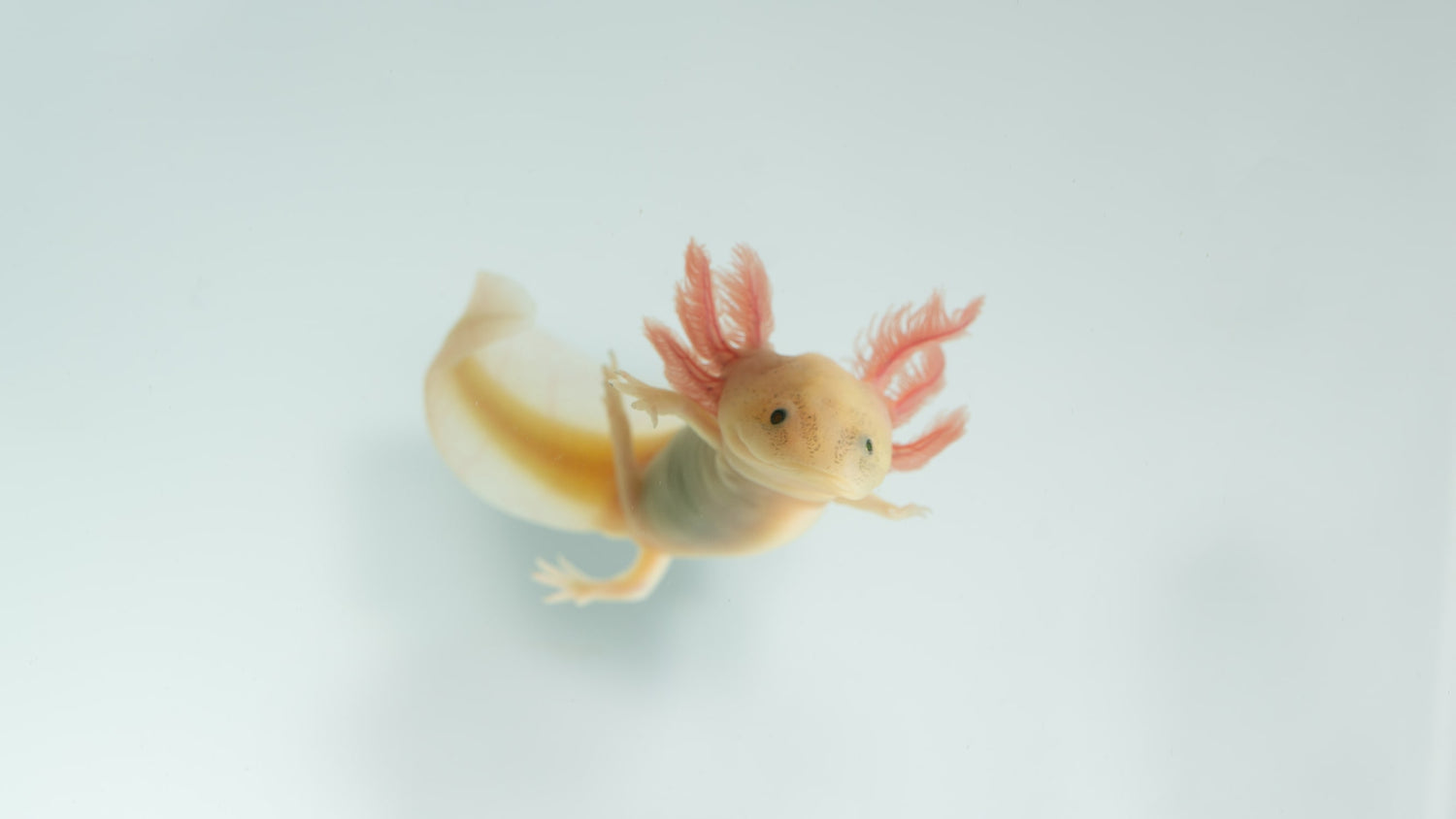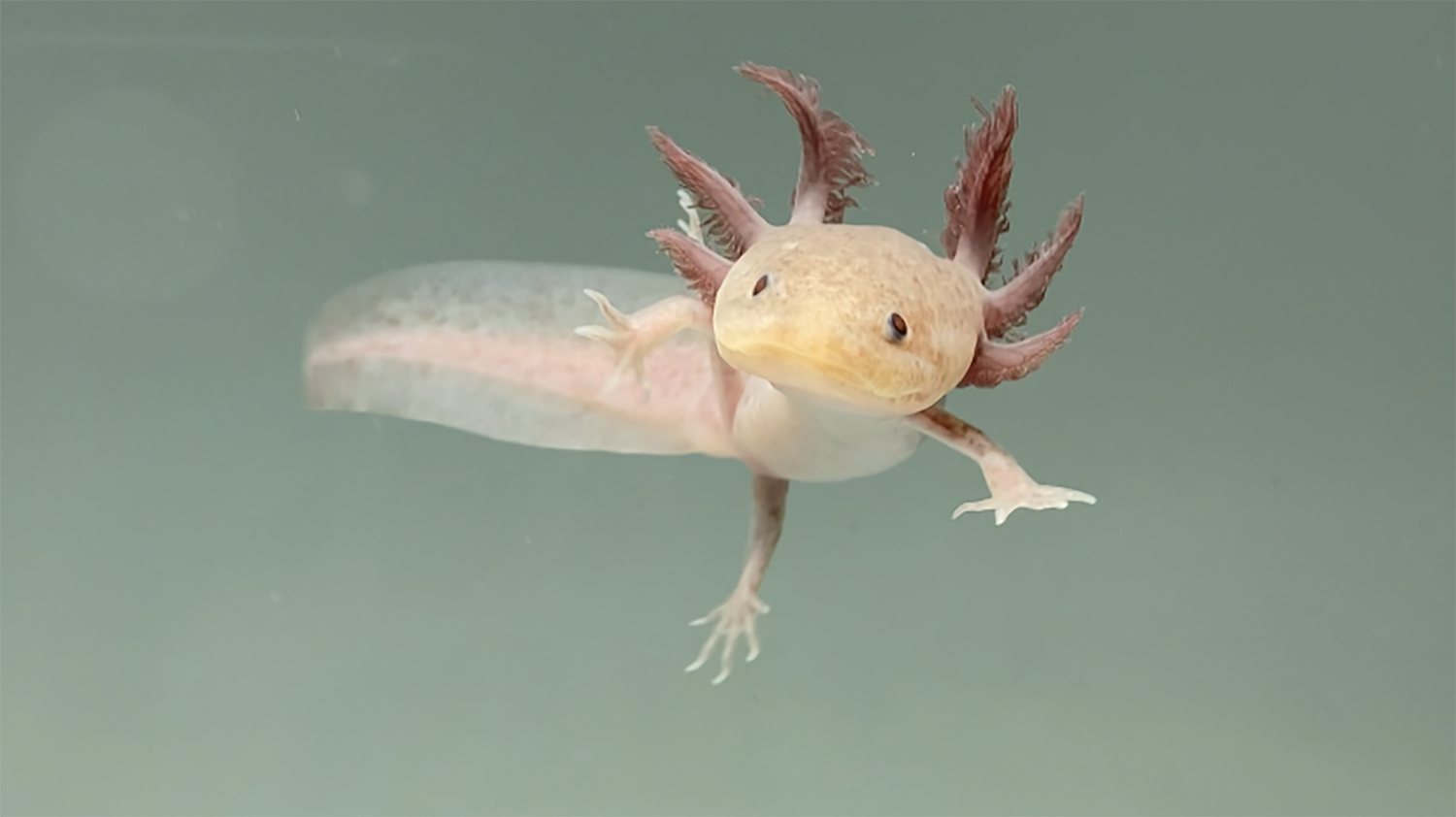About Your New Companion
Axolotls are a fascinating species of salamander whose scientific name is Ambystoma mexicanum. They have large, feathery gills, finned tails, and wide heads, and come in a variety of different colors and patterns, known as morphs. As neotenic salamanders, axolotls never undergo metamorphosis, retaining these characteristics throughout their entire lives and never emerging from the water. Under extremely rare circumstances, axolotls will metamorphosize into ordinary salamanders and adopt a more traditional amphibian lifestyle.
Axolotls are indigenous to only three lakes in the valley of Mexico, and of those, only one still exists today—Lake Xochimilco. Because of the loss of their natural habitat and extreme pollution from the ever-expanding human population nearby, the axolotl is classified as Critically Endangered by the IUCN Red List of Threatened Species. This is the last classification on the list above extinct in the wild.
In their natural environment, Axolotls are bottom-dwelling animals who spend most of their time living in the mud and plants beneath the shallow waters along the shores of Lake Xochimilco. They mostly eat worms, slugs, and insects. Because they live in mud, axolotls have evolved to have very poor eyesight. They use extremely powerful organs on the fronts of their faces to sense movement in the water, then inhale their prey as it swims past.
We are so excited that you are beginning the journey of owning your own exotic pet—an axolotl! We aim to make everything as easy as possible for you and your new pet, so read this guide to learn the basics of caring for your very own exotic Mexican walking fish, the Axolotl.
Acclimating Your Axolotl
Once you have achieved a healthy Nitrogen Cycle in your aquarium and your axolotl has finally made it back home, it is time to introduce it to its new habitat. There are two ways to acclimate your axolotl to its aquarium, and the method you should choose depends on how you purchased your animal. If you brought your axolotl home from our location by Dallas Love Field Airport and it has been in its bag for less than 24 hours, follow these instructions to properly acclimate your pet to its new home:
Proper Acclimation
- Open the bag holding your new axolotl and gently pour the water and the animal into a large bowl or container.
- Slowly add ¼ cup of water from your cycled aquarium to the container once every 5 minutes for 30 minutes.
- After 30 minutes, use a net to gently remove your axolotl from the container and place it into your aquarium.
- Do not pour the water from the container back into the aquarium!
If your axolotl was shipped in the mail and has been in the bag it was packaged in for longer than 24 hours, your animal should be acclimated and removed from its bag as quickly as possible. Follow the steps for the Rapid Acclimation method below:
Rapid Acclimation
- Take the bag holding your axolotl and, without opening it, place it into the aquarium water.
- Wait 15 minutes to allow the water temperatures in the bag and the aquarium to equalize.
- Use a net to gently remove your axolotl from the bag and place it into the aquarium.
- Do not spill any of the water from the bag into your new aquarium!
Once your new axolotl is in the aquarium, keep any aquarium lights off for 24 hours to help minimize your new pet's stress while it settles into its new habitat. After about a day or so, the axolotl should be ready for you to turn on the lights and let you attempt to feed it.
If your axolotl does not eat right away, it is most likely just taking more time to get comfortable with its new environment. If your axolotl’s problems persist, please read throughout the rest of the guide to determine what could cause the issue. If the cause of the problem still remains unclear, please contact the Axolotl Planet team and an expert will assist you as soon as possible!
Axolotl Aquarium Water Parameters
Water quality is the most important requirement to keeping your axolotl comfortable and healthy. All aquariums for axolotls must be cycled before introducing the axolotl to the aquarium. This will help keep your water clean and safe for the axolotl. Please read our guide on Tank Cycling to learn more about how to prepare your aquarium for an axolotl! After your tank is cycled, test your tank’s water quality regularly using a Master Freshwater Test Kit by API, which you can purchase online or from your local Petco, PetSmart, or fish store. Simply follow the instructions on the kit and you’ll be able to accurately test your water in minutes.
Here are the ideal water parameters for your axolotl:
- pH – Ideal: 7.4-7.6 | Acceptable: 6.5-8.0
- Ammonia – 0 parts per million
- Nitrates – between 5 and 20 parts per million
- Nitrites – 0 parts per million
- Temperature – 60–68°F; never higher than 72°F
Water for Axolotls and Water Conditioners
Not all sources of water or water conditioners are safe for your axolotl, so make sure that whatever water and conditioner you use is appropriate for your axolotl's needs. Conditioned tap water is the most common type of water for people to use, and as long as your tap water doesn't have unusually high levels of ammonia, nitrites, or nitrates, it should be perfectly safe to use!
Safe Water
- Conditioned Tap Water
- Spring Water
- Well Water (ensure that you know when your well gets shock treated by the city each year as there can be residual chlorine afterwards and you'll need water conditioner just to be safe)
Unsafe Water
- Reverse Osmosis Water
- Distilled Water
Both Distilled and Reverse Osmosis water lack vital minerals and salts that are necessary for your axolotl's health.
Safe Water Conditioners
The best water conditioners for axolotls are able to remove chlorine and chloramines from tap water as well as detoxify ammonia and nitrites! Here are our recommendations for water conditioners!
- Seachem Prime
- Fritz Complete
Unsafe Water Conditioners
Certain water conditioners may contain ingredients that are harmful to axolotls. Be sure to carefully read the ingredients list on any water conditioner and avoid conditioners that contain Aloe Vera or other plant extracts as these are toxic to axolotls.
Water Changes
In an axolotl aquarium with a stable nitrogen cycle, it will be necessary to perform a water change at least once a week. You should have some sort of siphon and a large bucket for performing water changes. Water changes should consist of removing approximately 20-30% of the water from the aquarium and replacing it with fresh, cold, conditioned water. If you are experiencing elevated levels of ammonia, nitrites, or nitrates, it may be necessary to do one larger or multiple smaller water changes, but you should never do a 100% water change unless your cycle has completely crashed or your tank has been contaminated by dangerous chemicals.
Proper Axolotl Aquarium Size
Since axolotls are bottom-feeding animals, the height of their aquarium is not as important as the length and width of it. Reaching an adult size of up to 10 inches in length or more, your axolotl needs plenty of room to turn around and fully extend its body in any direction. If an axolotl’s habitat is too small, it can cause stress for the animal, which can lead to health problems in the long term.
To accommodate the lifelong growth of your pet, we recommend nothing smaller than a 30 or 40-Gallon Breeder tank, along with a lid to prevent the axolotl from jumping out of its enclosure (it’s happened before!). This is a common aquarium size and they are readily available at most pet stores and fish shops.
Axolotl Aquarium Filtration
Axolotls evolved in the relatively still waters of Lake Xochimilco in the valley of Mexico. Therefore, you should avoid using filters and equipment that produce a high amount of water flow and surface agitation in your axolotl’s aquarium.
At the same time, axolotls also produce a significant amount of waste which can quickly pollute their water if there is inadequate filtration in the tank. Canister filters, hang-on-back filters, and internal filters with adjustable flow rates are all ideal—providing three types of filtration (mechanical, biological, and chemical) to help your axolotl thrive.
Another benefit of these three types of filters is that they allow you to aim the filtered water towards the surface of the tank. This helps prevent a buildup of debris and small particles from accumulating and creating a glossy film on the surface of the water.
A less expensive option, while not as effective, is a sponge filter. Although they lack chemical filtration, they still provide adequate mechanical and biological filtration as long as they are large enough to accommodate the filtration load of the aquarium and its resident(s).
Sponge filters will collect debris, waste, and other free-floating particles while simultaneously supplying plenty of surface area for beneficial bacteria to develop.
Filters do not eliminate the need for regular maintenance. All aquariums require routine maintenance to keep them running at their optimal performance, and to keep the animals living there happy and healthy. Practicing a regular water change routine and performing regular water tests is essential to make sure your axolotl’s environment is as comfortable and healthy as possible. There are many filter options available on the market. Here are some we recommend based on our many years of experience keeping aquatic animals:
Internal filters
- For a 20 Gallon Long tank, we recommend the Sicce Shark ADV 600
- For a 30-40 Gallon Breeder, we recommend the Sicce Shark ADV 800
- Hang-On-Back Filters
- For a 20 Gallon Long tank, we recommend the Seachem Tidal 35
- For a 30-40 Gallon Breeder, we recommend the Seachem Tidal 55
- Canister filters
- For a 20 Gallon Long tank, we recommend the Sicce Whale 120
- For a 30-40 Gallon Breeder, we recommend the Sicce Whale 200
- Sponge filters (These require an air pump and airline tubing)
- For a 20 Gallon Long tank, we recommend the Small Hikari Bacto-Surge Biological Action Sponge Filter
- For a 30-40 Gallon Breeder, we recommend the Large Hikari Bacto-Surge Biological Action Sponge Filter
Axolotl Aquarium Lighting
Axolotls in the wild are found living in dark spots under plants or rocks at the bottom of Lake Xochimilco. Because these animals spend their entire lives in relative darkness, they evolved over time without eyelids. In fact, Axolotls, like many other creatures, actually require very little to no light to survive.
Therefore, you do not need to install any special lighting systems for your axolotl—natural or indoor light will suffice. If your aquarium is brightly lit to promote the growth of aquatic plants, you must provide your axolotl with adequately dark hiding spots to escape it when they want.
Axolotl Aquarium Decor
Once you have chosen the proper aquarium size, filter, and lighting method for your new pet, decorating your tank—or aquascaping, as the hobbyists like to say—is the most fun part of all!
In captivity, a satisfactory axolotl habitat can range from something as simple as a bare-bottom aquarium with some flower pot “caves” to an elaborately assembled aquascape full of live plants resembling their native Lake Xochimilco. Regardless of how your pet’s home is decorated, there are a few guidelines you should follow to keep your axolotl safe and happy.
What not to use
- Gravel
- Small rocks
- Marbles
- Glass stones/pebbles
- Artificially colored or dyed sand
- Coarse sand
- Sharp rocks or other jagged decorations
Despite being popular in many home aquaria, axolotls have been known to accidentally swallow these items. Consuming these materials can cause impaction (a blockage) in the animal’s digestive system, which can be extremely harmful and often leads to death.
What to use
- Extremely fine sand (Only for axolotls over 6 inches long)
- Slate Tile
- A bare-bottom tank is also perfectly fine for an axolotl—they don’t mind.
- Artificial plants
- Live plants (Ensure that any live plants you choose to keep in your aquarium are able to thrive in low light and cold water conditions)
- Anubias
- Anacharis
- Java Fern
- Duckweed
- Brazilian Pennywort
- Java Moss
Axolotl Tank Mates
Axolotls are solitary animals, meaning they do not require tank mates or companionship. In many cases, it's best for them to be kept alone.
However, it is possible to successfully raise multiple axolotls in the same environment, provided you give them plenty of space and the proper amount of care. A 40-Gallon Breeder tank will provide the space necessary to comfortably keep two or three adult axolotls. To learn more about how to successfully keep multiple axolotls together, please click here!
When it comes to adding tank mates besides other axolotls, it should be done with extreme caution, or avoided completely. Fish have a tendency to nip at axolotls’ gills, legs, and tails, thinking they’re food. If they aren’t at least twice the size of your axolotl’s head, snails, clams, and other mollusks are likely to be swallowed, causing impaction and death. Invertebrates such as shrimp and crayfish are also likely to cause harm to axolotls by attacking their gills and limbs with their claws.
If your axolotl is 4 inches or longer, you can keep bladder/pond snails to help keep your aquarium environment clean.
If you want to give your axolotl a tank mate of any kind, consult a specialist or contact the Axolotl Planet team for guidance.
Axolotl Feeding
Adult axolotls should be fed once every 2-3 days, as much as they are willing to eat per feeding. Younger axolotls (less than 8 inches) should be fed once daily as much as they are willing to eat per feeding.
Food options include, but are not limited to, earthworms, black worms, insects, and small, freshwater feeder fish (Silversides). Note: Feeder fish must be quarantined for minimum two weeks and given broad spectrum treatments for parasitic, fungal, and bacterial infections. Feeding live fish will always come with the risk of your axolotl contracting an illness so we strongly recommend worms or non-live food options to avoid such risks.
Staple Foods
- Earthworms (Nightcrawlers) [For larger axolotls that are 4 inches and larger]
- European or Canadian Nightcrawlers are best
- Blackworms [For smaller axolotls 4 inches or smaller]
- Frozen & Thawed Feeder Fish (Silversides)
- Frozen Brine Shrimp Cubes
- Repashy Grub Pies
Occasional Foods
- Waxworms
- Hornworms (With horn removed)
- Crickets
- Bloodworms
You can feed other types of insects to your axolotl besides the ones on this list, but you should avoid feeding insects with tough exoskeletons, like mealworms. While crickets and mealworms both have exoskeletons, mealworms have especially tough exoskeletons that axolotls cannot digest well. Crickets should only be fed occasionally (1-2 times per month in small amounts). If you are unsure if a certain food option is okay for your axolotl, contact a specialist or consult the Axolotl Planet team for guidance.
Helpful Equipment and Supplies
The following is an incomplete list of supplies and tools you will find useful as you care for your axolotl. Most of these items can be found online or at major pet stores and aquatics shops. If you are unsure about anything on this list, or about a substitute for something on this list, contact the Axolotl Planet team for guidance.
- Water test kit (We recommend the Freshwater Master Test Kit by API)
- Water thermometer
- Conditioner to treat tap water (We recommend Prime by SeaChem)
- Siphon for water changes
- Indian almond leaves (For their anti-fungal, anti-bacterial, and antioxidant properties)
- Black Tea (To treat minor fungal infections)
- Methylene Blue (For severe cases of fungal and bacterial infections)
- PraziPro (To eliminate harmful parasites)
Signs of Stress in Axolotls
There are a number of different ways you can identify that an axolotl is experiencing stress, discomfort, or illness. The following is an incomplete list of symptoms to look for that indicate your pet is unhappy or sick. If you are unsure about some aspect of your axolotl’s behavior, read our #1 Guide to Axolotl Sickness and Health, then contact a specialist or consult the Axolotl Planet team for guidance.
- Loss of Appetite
- Deterioration of Gills
- Curled Gills
- Curled Tail Tip
- Frequent Gulps of Air
- Floating
- Frantic Swimming
- Lack of Responsiveness
- Loss of Color in Gills and/or Body
Talk to us!
If you’re having issues with your axolotl and you need some professional help, reach out to us directly by sending an email to info@axolotlplanet.com and we will get back to you as soon as possible! You can also get in touch with us from this page on our website, on Facebook or Instagram at @axolotlplanet, or by phone at (214) 679-4013! We’re here to help.
Conclusion
Axolotls are unquestionably among the most unique creatures in the world, and with the right care, they can make absolutely phenomenal pets. While their requirements are relatively simple, it is essential that the proper living conditions are maintained to keep your axolotl happy and healthy.
@axolotlplanet Mission failed successfully 🥲 #axolotlplanet #axolotl #axolotls #axolotlsoftiktok #fishtank #aquarium #fishtok #fishcontent ♬ original sound - Matthew Rincon





Leave a comment
This site is protected by hCaptcha and the hCaptcha Privacy Policy and Terms of Service apply.